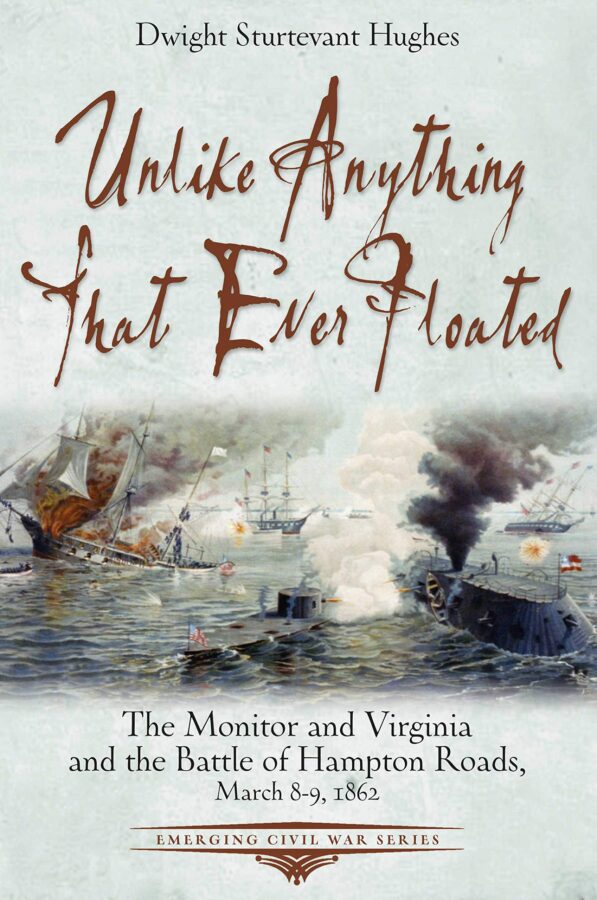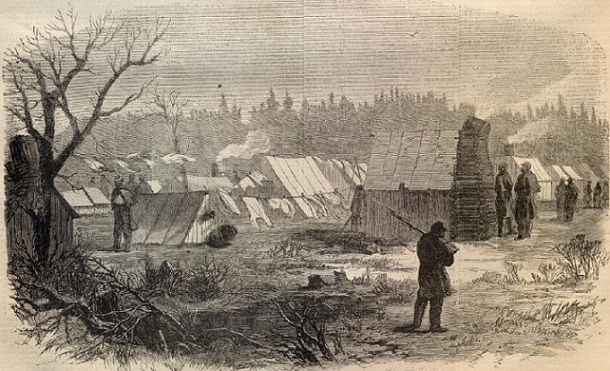Unlike Anything that Ever Floated: The Monitor and Virginia and the Battle of Hampton Roads, March 8–9, 1862 by Dwight Sturtevant Hughes. Savas Beatie, LLC, 2021. Paper, ISBN: 978-1-61121-525-0. $14.95.
 From the very first shots of the Civil War, it was apparent that control of maritime access to the self-proclaimed Confederate States would play a crucial role in the conflict’s outcome. The navigable rivers within the Confederacy—and the seas around it—were vital to the survival of the nascent slaveholding republic. The Confederacy, however, began the war with very little in terms of naval capability; moreover, they faced a relatively able, innovating, and heavily armed naval opponent. As such, the rebels sought technological innovation—made possible by the industrial scale production of iron and steam propulsion—to defend their waterways.
From the very first shots of the Civil War, it was apparent that control of maritime access to the self-proclaimed Confederate States would play a crucial role in the conflict’s outcome. The navigable rivers within the Confederacy—and the seas around it—were vital to the survival of the nascent slaveholding republic. The Confederacy, however, began the war with very little in terms of naval capability; moreover, they faced a relatively able, innovating, and heavily armed naval opponent. As such, the rebels sought technological innovation—made possible by the industrial scale production of iron and steam propulsion—to defend their waterways.
This sets the stage for Dwight Sturtevant Hughes’s new book, Unlike Anything That Ever Floated. As the title suggests, it focuses on the Battle of Hampton Roads in March 1862, made famous as the first encounter of two ironclad warships. The book is written as a narrative biography of the battle itself.
The first chapter begins with the USS Monitor departing New York harbor for the Chesapeake Bay and takes the story to the point the ship enters Hampton Roads to face off with the CSS Virginia (formerly the steam frigate USS Merrimack) on the evening of March 8. Earlier that day, the US Navy had been dealt its heaviest defeat in a single battle with the destruction of the USS Congress and USS Cumberland by the Confederacy’s new ironclad warship. The Monitor was tasked with defending the USS Minnesota, which had run hard aground during the action of the previous day.
The second chapter advances the story to the morning of March 9 and the opposing ironclad warships approaching each other, cleared for action for their famous duel. Chapters three through eight trace briefly the development of both ships and the battle of the Hampton Roads prior to the arrival of the Monitor. Chapters nine and ten provide a very detailed narrative of the climactic duel between the two ironclads.
Readers will find many useful maps, pictures, and cutaway diagrams of the USS Monitor and the CSS Virginia. The layout is impressive, and the prose is accessible to a lay audience. Impressively, Hughes supplies an engaging narrative that is not short on technical details.
The author might have done a bit more to contextualize Hampton Roads, both within the larger war and broader naval developments of the mid-nineteenth century. To be sure, a five-page foreword (written by Christopher L. Kolakowski) traces naval developments of five decades, from the 1850s to the turn of the twentieth century. However, this does not really answer the mail when it comes to the important implications of this battle beyond March 1862.
Still, readers looking for an introduction to the Battle of Hampton Roads should look no further than this sprite and entertaining book.
J. Ross Dancy is an assistant professor in the Joint Military Operations Department at the U.S. Naval War College.
